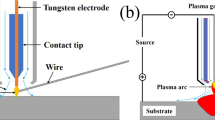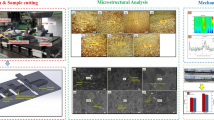Abstract
Adhesive bonding is a joining technology gaining popularity in automotive and aeronautic industries because it allows weight reduction, adhesive bonds and adhesive dissimilar materials joining which could be part of assembly to be welded to other structure, resulting in thermal cycle that could affect mechanical properties. Dissimilar joints between plates of dual-ten 590/600 dual phase high strength steel and AA6061T6-590 aluminum alloy bonded by MP55420 adhesive were analyzed by means of computational stress analysis, single lap shear testing, failure analysis, thermo-gravimetric analysis (TGA) and Fourier transform infrared spectroscopy (FTIR). Results indicated that after curing at 175 \(^\circ\)C during 75 and 120 min, stiffness (measured as Young modulus) increased, ductility was reduced, two principal decomposition stages of mass loss were located from 200 to 500 \(^\circ\)C in TGA graphs, and there was no significant change in adhesive chemistry considering FTIR curves. Moreover, maximum load of single lap shear specimens was reduced, color adhesive changed from bright to dark amber, as well as joints failed by adhesive mechanism surpassing shear-strain limit as curing time increased. Computational stress analysis showed that peak normal and shear stresses were generated on both edges of adhesive joints after post-treatment time increased.











Similar content being viewed by others
Data availability
The data presented in this research are the result of an original research and analysis work, whose main authorship is Dr. Celso Eduardo Cruz González.
Code availability
Not applicable.
References
Dorworth LC, Gardiner GL, Mellema GM (2019) Essentials of advanced composite fabrication and repair, 2nd edn. Aviation supplies and academics Inc., Reno, NV, USA, ISBN-13: 978-1-61954-762-9
Strong AB (2009) Fundamentals of composites manufacturing, materials, methods and applications, 2nd edn. Society of Manufacturing Engineers, MI, USA
Hernandez DA, Soufen CA, Orlandi MO (2017) Carbon fiber reinforced polymer and epoxy adhesive tensile test failure analysis using scanning electron microscopy. Mater Res 20(4):951–961. https://doi.org/10.1590/1980-5373-mr-2017-0229
da Silva L, Oschner A, Adams RD (2011) Handbook of Adhesion Technology. Springer-Verlag, Berlin Heidelberg, Berlin, Germany
André NM, Goushegir SM, Santos JFD, Canto LB, Amancio-Filho ST (2016) Influência da Espessura do Filme Polimérico Intermediário na Resistência Mecânica de Juntas Híbridas de Alumínio 2024–T3 e CF-PPS Produzidas por União Pontual por Fricção. Soldagem & Inspeção 21(1):2–15. https://doi.org/10.1590/0104-9224/SI2101.02
Alfano M, Morano C, Moroni F, Musiari F, Danilo Spennacchio G, Di Lonardo D (2018) Fracture toughness of structural adhesives for the automotive industry. Procedia Structural Integrity 8:561–565. https://doi.org/10.1016/j.prostr.2017.12.055
Ocaña R, Arenas J, Alía C, Narbón J (2015) Evaluation of degradation of structural adhesive joints in functional automotive applications. Procedia Eng 132:716–723. https://doi.org/10.1016/j.proeng.2015.12.552
Papadakis L, Schiel M, Vassilou V, Loizou A, Dilger K (2014) Adhesive bonding of attachments on alternate car shell surfaces in automotive final assembly lines. Procedia CIRP 18:180–185. https://doi.org/10.1016/j.procir.2014.06.128
Adhesive System Inc (2013) MP55420 Adhesive - Technical datasheet. Adhesive System Inc., USA
Ebnesajjad S, Landrock AH (2015) Adhesives technology handbook, 3rd edn. Elsevier, Boston, MA, USA
Gasson PC (2013) Welding and Joining of Aerospace Materials Edited by M. C. Chaturvedi Woodhead Publishing, 80 High Street, Sawston, Cambridge, CB22 3HJ, UK. 2012. 430pp. Illustrated. £155. ISBN 978-1-84569-532-3. Aeronaut J 117(1187):89–90. http://doi.org/10.1017/S000192400000779X
Michael A, Irene A (2013) Handbook of paper and pulp chemicals. Synapse Information resources Inc., New York, USA
SCIGRIP (2015) An Introduction to MMA Structural Adhesives. SCIGRIP Smarter Adhesive Solutions, United Kingdom, URL https://www.compositesworld.com/cdn/cms/cw_whitepaper_scigrip_mma_intro.pdf, retrieved March 3rd, 2022
Crocombe A (2009) Adhesive bonding, science, technology and applications, Woodhead Publishers, FL, USA, chap Chapter 5: Stress analysis, pp 91–122
American Welding Society (2001) In: Welding Handbook 1 - Welding science and technology, vol 1. AWS, FL, USA
Grant L, Adams R, da Silva LF (2009) Effect of the temperature on the strength of adhesively bonded single lap and T joints for the automotive industry. Int J Adhes Adhes 29(5):535–542. https://doi.org/10.1016/j.ijadhadh.2009.01.002
da Silva LF, Adams R (2007) Adhesive joints at high and low temperatures using similar and dissimilar adherends and dual adhesives. Int J Adhes Adhes 27(3):216–226. https://doi.org/10.1016/j.ijadhadh.2006.04.002
Suhir E (2000) Adhesively bonded assemblies with identical nondeformable adherends and ‘piecewise continuous’ adhesive layer: predicted thermal stresses in the adhesive. Int J Solids Struct 37(16):2229–2252. https://doi.org/10.1016/S0020-7683(98)00317-5
Carbas R, da Silva L, Marques E, Lopes A (2013) Effect of post-cure on the glass transition temperature and mechanical properties of epoxy adhesives. J Adhes Sci Technol 27(23):2542–2557. https://doi.org/10.1080/01694243.2013.790294
Marra J, Paleari AG, Pero AC, de Souza RF, Barbosa DB, Compagnoni MA (2009) Effect of methyl methacrylate monomer on bond strength of denture base resin to acrylic teeth. Int J Adhes Adhes 29(4):391–395. https://doi.org/10.1016/j.ijadhadh.2008.06.009
ASTM-International (2021a) Metals - Mechanical Testing; Elevated and Low-Temperature Tests; Metallography, vol 03.01, ASTM International, USA, chap ASTM E8/E8M-21. Standard test methods for tension testing of metallic materials. https://doi.org/10.1520/E0008_E0008M-21
ASTM-International (2017a) Analytical Chemistry For Metals, Ores, And Related Materials, vol 03.05, ASTM International, USA, chap ASTM E415. Standard test method for analysis of carbon and low-alloy steel by spark atomic emission spectrometry. http://doi.org/10.1520/E0415-14
ASTM-International (2017b) Analytical Chemistry For Metals, Ores, And Related Materials, vol 03.05, ASTM International, USA, chap ASTM E1251-17a. Standard test method for analysis of aluminum and aluminum alloys by spark atomic emission spectrometry. http://doi.org/10.1520/E1251-17A
ASTM-International (2008) Statistical Methods; Hazard Potential Of Chemicals; Thermal Measurements; Manufacture Of Pharmaceutical And Biopharmaceutical Products; Healthcare Informatics, vol 14.01, ASTM International, USA, chap ASTM E1131-08. Standard test method for compositional analysis by thermogravimetry. http://doi.org/10.1520/E1131-08
Wagner M (2018) Thermal Analysis in Practice. Carl Hanser Verlag GmbH and Co., Germany
ASTM-International (2021b) Molecular Spectroscopy And Separation Science; Surface Analysis, vol 03.06, ASTM International, USA, chap ASTM E1252-98(2021). Standard practice for general techniques for obtaining infrared spectra for qualitative analysis. http://doi.org/10.1520/E1252-98R21
ASTM-International (2010) Adhesives, vol 15.06, ASTM International, USA, chap ASTM D1002-99. Standard test method for apparent shear strength of single-lap-joint adhesively bonded metal specimens by tension loading (metal-to metal). http://doi.org/10.1520/D1002-99
National Institute of Standards and Technology (2018) Web chemical handbook SRD 69, Methyl methacrylate. NIST, URL https://webbook.nist.gov/cgi/cbook.cgi?ID=C80626&Type=IR-SPEC&Index=0
Banea M, Rosioara M, Carbas R, da Silva L (2018) Multi-material adhesive joints for automotive industry. Compos Part B Eng 151:71–77. https://doi.org/10.1016/j.compositesb.2018.06.009. URL https://linkinghub.elsevier.com/retrieve/pii/S1359836818310072
Cruz-G CE, Akhavan-Safar A, da Silva LFM, Ayatollahi MR (2020) On the evaluation of a critical distance approach for failure load prediction of adhesively bonded dissimilar materials. Contin Mech Thermodyn 32(6):1647–1657. https://doi.org/10.1007/s00161-020-00871-7. URL http://link.springer.com/10.1007/s00161-020-00871-7
Aerospace Specification Metals Inc. Subcategory: 6000 series aluminum alloy; aluminum alloy; metal; nonferrous metal. Web page. URL http://asm.matweb.com/search/SpecificMaterial.asp?bassnum=ma6061t6, retrieved March 3rd, 2022
Docol Automotive Steels (2018) Docol 590DP - Dual-phase steel for automotive applications. Docol by SSAB Inc., AL, USA
Duan G, Zhang C, Li A, Yang X, Lu L, Wang X (2008) Preparation and characterization of mesoporous zirconia made by using a poly (methyl methacrylate) template. Nanoscale Res Lett 3(3):118. https://doi.org/10.1007/s11671-008-9123-7
Her SC, Chan CF (2019) Interfacial stress analysis of adhesively bonded lap joint. Materials 12(15):2403. https://doi.org/10.3390/ma12152403
Perez Mora R, Cruz Gonzalez CE, Santillan Gutierrez SD, Taha Tijerina JJ, Vargas Arista B, Barba Pingarron A (2019) Fatigue strength evaluation and fracture behavior of joined dual phase steel/AA6061-T6 aluminum alloy. Frattura ed Integrità Strutturale 13(48):530–544. https://doi.org/10.3221/IGF-ESIS.48.51
Cruz C, Vargas B, Capula S, Terán G, Guzmán I, Granda E (2021) Experimental and finite element analysis of a damaged API5L X52 pipeline with longitudinal crack repaired by adhesively bonded metallic patch. J Adhes Sci Technol 35(11):1170–1184. https://doi.org/10.1080/01694243.2020.1838109
Acknowledgements
The authors wish to thank CONACYT for the experimental support received, as well as Eneftali Flores García from CIDESI Querétaro for technical support.
Author information
Authors and Affiliations
Contributions
All authors have contributed to this manuscript. Celso E. Cruz González: Main research idea, main author, data collection and analysis, article writing. Benjamin Vargas Arista: Data analysis and results. Saul D. Santillan-Gutierrez: Carrying out experimentation, analysis of results. Arturo Barba Pingarrón: Carrying out experimentation, analysis and writing of conclusions according to the results obtained. Isidro Guzmán Flores: Correspondence, article writing, analysis of results.
Corresponding author
Ethics declarations
Ethics approval
We the authors, Celso E. Cruz-González, Benjamín Vargas Arista, Saúl D. Santillán-Gutiérrez, Arturo Barba Pingarrón, and Isidro Guzmán Flores, declare that we have no conflict of interest and our research is an original research, in which we do not receive any financial support to carry it out. In this Ethical approval, we establish the following: This manuscript has not been sent to another journal for review and publication. Animals, humans and any living being were not used in the present investigation; the personal data and affiliation data of the authors of this article, are true and can be used by the IJAMT. We the authors authorize the possible publication of this article, because our publication is original, and we have no conflict of interest.
Consent to participate
Dr. Celso E. Cruz-González, Dr. Benjamín Vargas-Arista, Dr. Saúl D. Santillán-Gutiérrez, and Dr. Arturo Barba Pingarrón designate as corresponding author PhD. Isidro Guzmán Flores; for this reason, we give our consent to participate in the review process, evaluation, and publication of the article “Effect of curing post-treatment time on mechanical properties and stress distribution of adhesively bonded dissimilar steel-aluminum joints”.
Consent for publication
We the authors, Dr. Celso E. Cruz-González, Dr. Benjamín Vargas-Arista, Dr. Saúl D. Santillán-Gutiérrez, Dr. Arturo Barba Pingarrón, and Isidro Guzmán Flores, consent and approve the publication of this article.
Competing interests
The authors declare no competing interests.
Additional information
Publisher’s Note
Springer Nature remains neutral with regard to jurisdictional claims in published maps and institutional affiliations.
Rights and permissions
About this article
Cite this article
Cruz-González, C.E., Vargas-Arista, B., Santillán-Gutiérrez, S.D. et al. Effect of curing post-treatment time on mechanical properties and stress distribution of adhesively bonded dissimilar steel-aluminum joints. Int J Adv Manuf Technol 121, 4929–4940 (2022). https://doi.org/10.1007/s00170-022-09585-3
Received:
Accepted:
Published:
Issue Date:
DOI: https://doi.org/10.1007/s00170-022-09585-3




